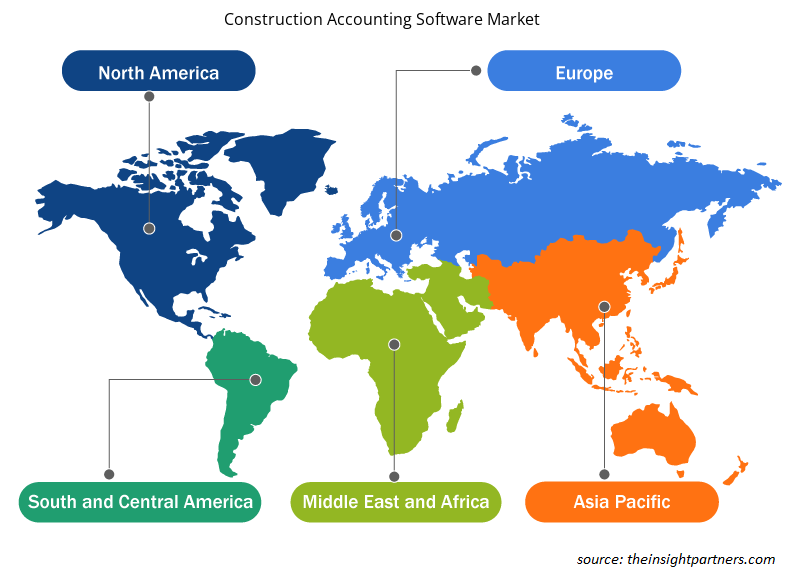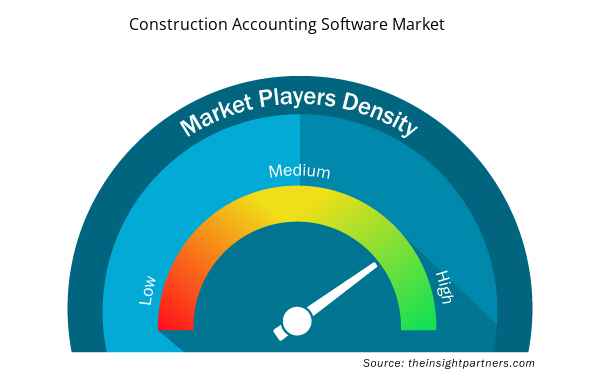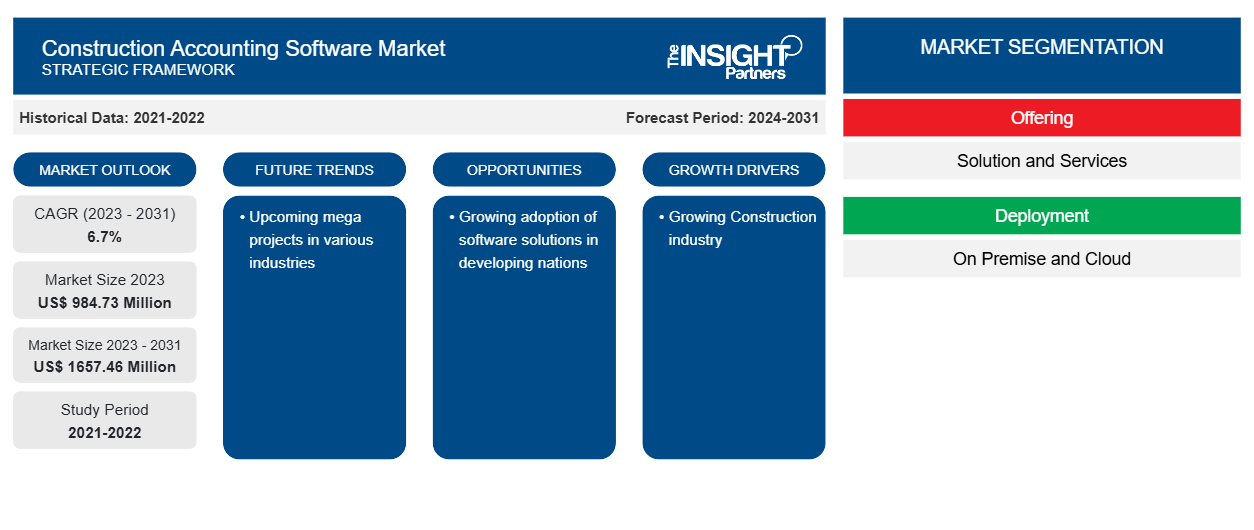Si prevede che la dimensione del mercato del software di contabilità edile raggiungerà 1657,46 milioni di dollari entro il 2031, rispetto ai 984,73 milioni di dollari del 2023. Si prevede che il mercato registrerà un CAGR del 6,7% nel periodo 2023-2031. La crescente digitalizzazione nel settore edile e l'industria edile in crescita rimarranno probabilmente tendenze chiave nel mercato.
Analisi di mercato del software di contabilità edile
La crescente domanda da parte dei settori residenziale e commerciale alimenta la crescita del settore edile. Questo fattore sta portando all'adozione di software di contabilità edile da parte della gestione finanziaria delle aziende edili. Il software aiuta le aziende edili a tracciare con precisione il denaro in entrata e in uscita dalle loro attività. Il software gestisce aspetti del settore edile, come la determinazione dei costi di commessa e la ritenuta. Tali caratteristiche del software di contabilità edile ne hanno portato all'adozione.
Panoramica del mercato del software di contabilità edile
Il software di contabilità edile fornisce strumenti di gestione finanziaria alle piccole e medie imprese edili e alle grandi imprese edili per progetti e attività di costruzione. Questa soluzione software offre funzionalità quali buste paga, costi di commessa, contabilità generale, conti da pagare e da ricevere (AP/AR), reportistica di audit e altro. Alcune soluzioni di contabilità edile si concentrano su informazioni finanziarie specifiche per i progetti, mentre altre forniscono approfondimenti contabili sull'intera azienda.
Personalizza questo report in base alle tue esigenze
Riceverai la personalizzazione gratuita di qualsiasi report, comprese parti di questo report, o analisi a livello nazionale, pacchetto dati Excel, oltre a usufruire di grandi offerte e sconti per start-up e università
- Scopri le principali tendenze di mercato in questo rapporto.Questo campione GRATUITO includerà analisi di dati che spaziano dalle tendenze di mercato alle stime e alle previsioni.
Driver e opportunità di mercato per il software di contabilità edile
Crescita del settore delle costruzioni
Il settore delle costruzioni è in prima linea nello sviluppo e nel miglioramento delle infrastrutture come strade, ferrovie, aeroporti e porti. Questi investimenti infrastrutturali migliorano la connettività, il commercio e lo sviluppo economico di qualsiasi paese. Pertanto, il crescente settore delle costruzioni sta alimentando l'adozione di software di contabilità per le costruzioni, che viene utilizzato per applicazioni contabili, tra cui conti da pagare, conti da ricevere, buste paga e contabilità generale, nonché moduli per costi di lavoro, stime, controllo delle attrezzature, controllo dell'inventario, ordini di acquisto, ordini di lavoro e fatture AIA.
Crescente adozione di soluzioni software nei paesi in via di sviluppo
Le nazioni in via di sviluppo come India e Cina stanno rapidamente abbracciando la digitalizzazione, che sta portando all'adozione di soluzioni software in vari settori, tra cui l'edilizia. Questi paesi stanno ampiamente adottando software di contabilità edile per affrontare sfide come fogli di calcolo complessi, ricevute perse e scartoffie infinite. L'adozione del software fornisce funzionalità di gestione finanziaria per le aziende edili.digitalization, which is leading to the adoption of software solutions in various industries, including the construction industry. These countries are widely adopting construction accounting software to tackle challenges such as complex spreadsheets, lost receipts, and never-ending paperwork. The software adoption provides financial management functionality for construction firms.
Analisi della segmentazione del rapporto di mercato del software di contabilità edile
I segmenti chiave che hanno contribuito alla derivazione dell'analisi di mercato del software di contabilità edile sono l'offerta, la distribuzione e l'applicazione.
- In base all'offerta, il mercato del software di contabilità edile è suddiviso in soluzioni e servizi. Il segmento delle soluzioni ha la quota di mercato più grande nel 2023.
- Per distribuzione, il mercato è segmentato in on premise e cloud . Si prevede che il segmento cloud crescerà con il CAGR più elevato.CAGR.
- Per applicazione, il mercato è segmentato in piccole e medie imprese edili e grandi imprese edili. Si prevede che il segmento delle piccole e medie imprese edili crescerà con il CAGR più elevato.CAGR.
Analisi della quota di mercato del software di contabilità edile per area geografica
L'ambito geografico del rapporto sul mercato dei software di contabilità per l'edilizia è suddiviso principalmente in cinque regioni: Nord America, Asia Pacifico, Europa, Medio Oriente e Africa, e Sud e Centro America.
La regione del Nord America deteneva una quota di mercato significativa. Il crescente settore delle costruzioni è il fattore principale che guida il mercato nella regione. Il settore delle costruzioni è uno dei maggiori contributori all'economia dei paesi della regione, il che ha portato all'adozione di soluzioni software per semplificare le attività nella contabilità delle costruzioni. I crescenti progetti di costruzione e il crescente settore residenziale stanno alimentando la crescita del mercato.
Approfondimenti regionali sul mercato del software di contabilità edile
Le tendenze regionali e i fattori che influenzano il mercato del software di contabilità edile durante il periodo di previsione sono stati ampiamente spiegati dagli analisti di Insight Partners. Questa sezione discute anche i segmenti e la geografia del mercato del software di contabilità edile in Nord America, Europa, Asia Pacifico, Medio Oriente e Africa e America centrale e meridionale.

- Ottieni i dati specifici regionali per il mercato del software di contabilità edile
Ambito del rapporto di mercato sul software di contabilità edile
| Attributo del report | Dettagli |
|---|---|
| Dimensioni del mercato nel 2023 | 984,73 milioni di dollari USA |
| Dimensioni del mercato entro il 2031 | 1657,46 milioni di dollari USA |
| CAGR globale (2023-2031) | 6,7% |
| Dati storici | 2021-2022 |
| Periodo di previsione | 2024-2031 |
| Segmenti coperti | Offrendo
|
| Regioni e Paesi coperti | America del Nord
|
| Leader di mercato e profili aziendali chiave |
|
Densità dei player del mercato del software di contabilità edile: comprendere il suo impatto sulle dinamiche aziendali
Il mercato del software di contabilità edile sta crescendo rapidamente, spinto dalla crescente domanda degli utenti finali dovuta a fattori quali l'evoluzione delle preferenze dei consumatori, i progressi tecnologici e una maggiore consapevolezza dei vantaggi del prodotto. Con l'aumento della domanda, le aziende stanno ampliando le loro offerte, innovando per soddisfare le esigenze dei consumatori e capitalizzando sulle tendenze emergenti, il che alimenta ulteriormente la crescita del mercato.
La densità degli operatori di mercato si riferisce alla distribuzione di aziende o società che operano in un particolare mercato o settore. Indica quanti concorrenti (operatori di mercato) sono presenti in un dato spazio di mercato in relazione alle sue dimensioni o al valore di mercato totale.
Le principali aziende che operano nel mercato del software di contabilità edile sono:
- Gruppo Sage plc
- Chetu Inc
- Tecnologie Procore
- Deltek Inc
- Fondazione Software, LLC
- Libro fresco
Disclaimer : le aziende elencate sopra non sono classificate secondo un ordine particolare.

- Ottieni una panoramica dei principali attori del mercato del software di contabilità edile
Notizie di mercato e sviluppi recenti del software di contabilità edile
Il mercato del software di contabilità edile viene valutato raccogliendo dati qualitativi e quantitativi dopo la ricerca primaria e secondaria, che include importanti pubblicazioni aziendali, dati associativi e database. Di seguito sono elencati alcuni degli sviluppi nel mercato del software di contabilità edile:
- Kojo, la piattaforma leader per la gestione di materiali e inventario del settore edile, ha annunciato il lancio di Kojo AP (accounts suppliers). Kojo AP è una suite di funzionalità creata appositamente per i team di contabilità delle costruzioni commerciali per affrontare la fase finale del flusso di lavoro di gestione dei materiali: i pagamenti. Kojo AP elimina molti dei processi di immissione manuale dei dati per i team di contabilità degli appaltatori, rilevando automaticamente gli errori nelle fatture e consentendo ai fornitori di essere pagati direttamente in un unico sistema. (Fonte: Kojo, comunicato stampa, maggio 2024)
Copertura e risultati del rapporto di mercato sul software di contabilità edile
Il rapporto "Dimensioni e previsioni del mercato del software di contabilità edile (2021-2031)" fornisce un'analisi dettagliata del mercato che copre le seguenti aree:
- Dimensioni e previsioni del mercato del software di contabilità edile a livello globale, regionale e nazionale per tutti i principali segmenti di mercato coperti dall'ambito
- Tendenze del mercato del software di contabilità edile, nonché dinamiche di mercato quali driver, vincoli e opportunità chiave
- Analisi dettagliata delle cinque forze PEST/Porter e SWOT
- Analisi di mercato del software di contabilità edile che copre le principali tendenze del mercato, il quadro globale e regionale, i principali attori, le normative e i recenti sviluppi del mercato
- Analisi del panorama industriale e della concorrenza che copre la concentrazione del mercato, l'analisi della mappa di calore, i principali attori e gli sviluppi recenti per il mercato del software di contabilità edile
- Profili aziendali dettagliati
- Analisi storica (2 anni), anno base, previsione (7 anni) con CAGR
- Analisi PEST e SWOT
- Valore/volume delle dimensioni del mercato - Globale, regionale, nazionale
- Industria e panorama competitivo
- Set di dati Excel



Report Coverage
Revenue forecast, Company Analysis, Industry landscape, Growth factors, and Trends

Segment Covered
This text is related
to segments covered.

Regional Scope
North America, Europe, Asia Pacific, Middle East & Africa, South & Central America

Country Scope
This text is related
to country scope.
Domande frequenti
The estimated value of the construction accounting software market will be US$ 1657.46 million by 2031.
Sage Group plc; Chetu Inc.; Procore Technologies; Deltek Inc.; Foundation Software, LLC; Fresh book; Intuit Inc.; Buildertrend; Viewpoint Inc.; and Xero Limited are some of the key players operating in the construction accounting software market.
Upcoming mega projects in various industries are considered a key trend in the construction accounting software market.
The growing digitalization in the construction industry and the rising construction industry are the key driving factors impacting the construction accounting software market.
The global construction accounting software market is estimated to register a CAGR of 6.7% during the forecast period 2023–2031.
Trends and growth analysis reports related to Technology, Media and Telecommunications : READ MORE..
The Insight Partners performs research in 4 major stages: Data Collection & Secondary Research, Primary Research, Data Analysis and Data Triangulation & Final Review.
- Data Collection and Secondary Research:
As a market research and consulting firm operating from a decade, we have published and advised several client across the globe. First step for any study will start with an assessment of currently available data and insights from existing reports. Further, historical and current market information is collected from Investor Presentations, Annual Reports, SEC Filings, etc., and other information related to company’s performance and market positioning are gathered from Paid Databases (Factiva, Hoovers, and Reuters) and various other publications available in public domain.
Several associations trade associates, technical forums, institutes, societies and organization are accessed to gain technical as well as market related insights through their publications such as research papers, blogs and press releases related to the studies are referred to get cues about the market. Further, white papers, journals, magazines, and other news articles published in last 3 years are scrutinized and analyzed to understand the current market trends.
- Primary Research:
The primarily interview analysis comprise of data obtained from industry participants interview and answers to survey questions gathered by in-house primary team.
For primary research, interviews are conducted with industry experts/CEOs/Marketing Managers/VPs/Subject Matter Experts from both demand and supply side to get a 360-degree view of the market. The primary team conducts several interviews based on the complexity of the markets to understand the various market trends and dynamics which makes research more credible and precise.
A typical research interview fulfils the following functions:
- Provides first-hand information on the market size, market trends, growth trends, competitive landscape, and outlook
- Validates and strengthens in-house secondary research findings
- Develops the analysis team’s expertise and market understanding
Primary research involves email interactions and telephone interviews for each market, category, segment, and sub-segment across geographies. The participants who typically take part in such a process include, but are not limited to:
- Industry participants: VPs, business development managers, market intelligence managers and national sales managers
- Outside experts: Valuation experts, research analysts and key opinion leaders specializing in the electronics and semiconductor industry.
Below is the breakup of our primary respondents by company, designation, and region:

Once we receive the confirmation from primary research sources or primary respondents, we finalize the base year market estimation and forecast the data as per the macroeconomic and microeconomic factors assessed during data collection.
- Data Analysis:
Once data is validated through both secondary as well as primary respondents, we finalize the market estimations by hypothesis formulation and factor analysis at regional and country level.
- Macro-Economic Factor Analysis:
We analyse macroeconomic indicators such the gross domestic product (GDP), increase in the demand for goods and services across industries, technological advancement, regional economic growth, governmental policies, the influence of COVID-19, PEST analysis, and other aspects. This analysis aids in setting benchmarks for various nations/regions and approximating market splits. Additionally, the general trend of the aforementioned components aid in determining the market's development possibilities.
- Country Level Data:
Various factors that are especially aligned to the country are taken into account to determine the market size for a certain area and country, including the presence of vendors, such as headquarters and offices, the country's GDP, demand patterns, and industry growth. To comprehend the market dynamics for the nation, a number of growth variables, inhibitors, application areas, and current market trends are researched. The aforementioned elements aid in determining the country's overall market's growth potential.
- Company Profile:
The “Table of Contents” is formulated by listing and analyzing more than 25 - 30 companies operating in the market ecosystem across geographies. However, we profile only 10 companies as a standard practice in our syndicate reports. These 10 companies comprise leading, emerging, and regional players. Nonetheless, our analysis is not restricted to the 10 listed companies, we also analyze other companies present in the market to develop a holistic view and understand the prevailing trends. The “Company Profiles” section in the report covers key facts, business description, products & services, financial information, SWOT analysis, and key developments. The financial information presented is extracted from the annual reports and official documents of the publicly listed companies. Upon collecting the information for the sections of respective companies, we verify them via various primary sources and then compile the data in respective company profiles. The company level information helps us in deriving the base number as well as in forecasting the market size.
- Developing Base Number:
Aggregation of sales statistics (2020-2022) and macro-economic factor, and other secondary and primary research insights are utilized to arrive at base number and related market shares for 2022. The data gaps are identified in this step and relevant market data is analyzed, collected from paid primary interviews or databases. On finalizing the base year market size, forecasts are developed on the basis of macro-economic, industry and market growth factors and company level analysis.
- Data Triangulation and Final Review:
The market findings and base year market size calculations are validated from supply as well as demand side. Demand side validations are based on macro-economic factor analysis and benchmarks for respective regions and countries. In case of supply side validations, revenues of major companies are estimated (in case not available) based on industry benchmark, approximate number of employees, product portfolio, and primary interviews revenues are gathered. Further revenue from target product/service segment is assessed to avoid overshooting of market statistics. In case of heavy deviations between supply and demand side values, all thes steps are repeated to achieve synchronization.
We follow an iterative model, wherein we share our research findings with Subject Matter Experts (SME’s) and Key Opinion Leaders (KOLs) until consensus view of the market is not formulated – this model negates any drastic deviation in the opinions of experts. Only validated and universally acceptable research findings are quoted in our reports.
We have important check points that we use to validate our research findings – which we call – data triangulation, where we validate the information, we generate from secondary sources with primary interviews and then we re-validate with our internal data bases and Subject matter experts. This comprehensive model enables us to deliver high quality, reliable data in shortest possible time.


 Ottieni un campione gratuito per questo repot
Ottieni un campione gratuito per questo repot